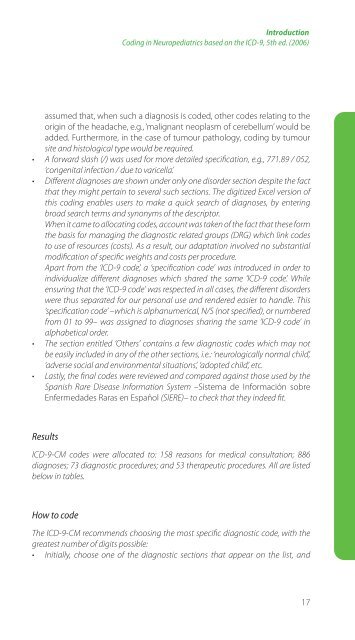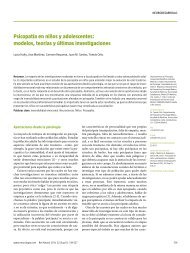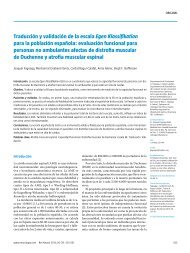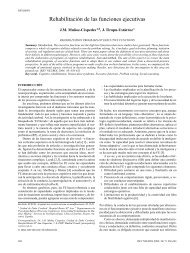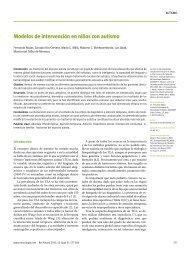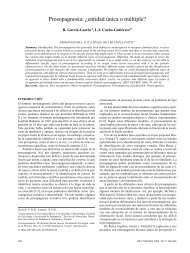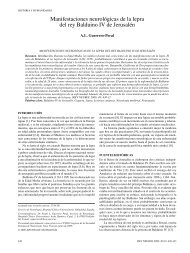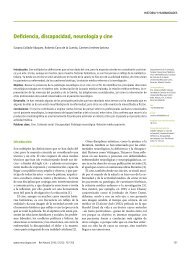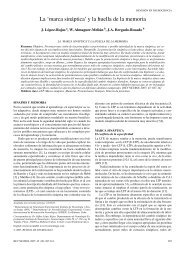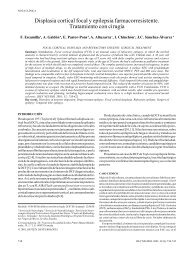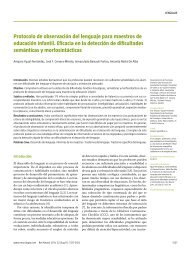Codificación en Neurología Pediátrica (CIE-9) - Revista de Neurología
Codificación en Neurología Pediátrica (CIE-9) - Revista de Neurología
Codificación en Neurología Pediátrica (CIE-9) - Revista de Neurología
You also want an ePaper? Increase the reach of your titles
YUMPU automatically turns print PDFs into web optimized ePapers that Google loves.
assumed that, wh<strong>en</strong> such a diagnosis is co<strong>de</strong>d, other co<strong>de</strong>s relating to the<br />
origin of the headache, e.g., ‘malignant neoplasm of cerebellum’ would be<br />
ad<strong>de</strong>d. Furthermore, in the case of tumour pathology, coding by tumour<br />
site and histological type would be required.<br />
• A forward slash (/) was used for more <strong>de</strong>tailed specification, e.g., 771.89 / 052,<br />
‘cong<strong>en</strong>ital infection / due to varicella’.<br />
• Differ<strong>en</strong>t diagnoses are shown un<strong>de</strong>r only one disor<strong>de</strong>r section <strong>de</strong>spite the fact<br />
that they might pertain to several such sections. The digitized Excel version of<br />
this coding <strong>en</strong>ables users to make a quick search of diagnoses, by <strong>en</strong>tering<br />
broad search terms and synonyms of the <strong>de</strong>scriptor.<br />
Wh<strong>en</strong> it came to allocating co<strong>de</strong>s, account was tak<strong>en</strong> of the fact that these form<br />
the basis for managing the diagnostic related groups (DRG) which link co<strong>de</strong>s<br />
to use of resources (costs). As a result, our adaptation involved no substantial<br />
modification of specific weights and costs per procedure.<br />
Apart from the ‘ICD-9 co<strong>de</strong>’, a ‘specification co<strong>de</strong>’ was introduced in or<strong>de</strong>r to<br />
individualize differ<strong>en</strong>t diagnoses which shared the same ‘ICD-9 co<strong>de</strong>’. While<br />
<strong>en</strong>suring that the ‘ICD-9 co<strong>de</strong>’ was respected in all cases, the differ<strong>en</strong>t disor<strong>de</strong>rs<br />
were thus separated for our personal use and r<strong>en</strong><strong>de</strong>red easier to handle. This<br />
‘specification co<strong>de</strong>’ –which is alphanumerical, N/S (not specified), or numbered<br />
from 01 to 99– was assigned to diagnoses sharing the same ‘ICD-9 co<strong>de</strong>’ in<br />
alphabetical or<strong>de</strong>r.<br />
• The section <strong>en</strong>titled ‘Others’ contains a few diagnostic co<strong>de</strong>s which may not<br />
be easily inclu<strong>de</strong>d in any of the other sections, i.e.: ‘neurologically normal child’,<br />
‘adverse social and <strong>en</strong>vironm<strong>en</strong>tal situations’, ‘adopted child’, etc.<br />
• Lastly, the final co<strong>de</strong>s were reviewed and compared against those used by the<br />
Spanish Rare Disease Information System –Sistema <strong>de</strong> Información sobre<br />
Enfermeda<strong>de</strong>s Raras <strong>en</strong> Español (SIERE)– to check that they in<strong>de</strong>ed fit.<br />
Results<br />
ICD-9-CM co<strong>de</strong>s were allocated to: 158 reasons for medical consultation; 886<br />
diagnoses; 73 diagnostic procedures; and 53 therapeutic procedures. All are listed<br />
below in tables.<br />
How to co<strong>de</strong><br />
Introduction<br />
Coding in Neuropediatrics based on the ICD-9, 5th ed. (2006)<br />
The ICD-9-CM recomm<strong>en</strong>ds choosing the most specific diagnostic co<strong>de</strong>, with the<br />
greatest number of digits possible:<br />
• Initially, choose one of the diagnostic sections that appear on the list, and<br />
17


